Jeeper, a strange name in the Champagne universe, symbol of the French liberation. In a few years’ time it has become one of the most audacious Champagnes. It dares an original design, the gastronomy, off the beaten tracks and frees its bubbles beside the greatest. It was known as the wine of the victory, it has been recognized as the wine of consecration: the brand launches a Premier Cru.
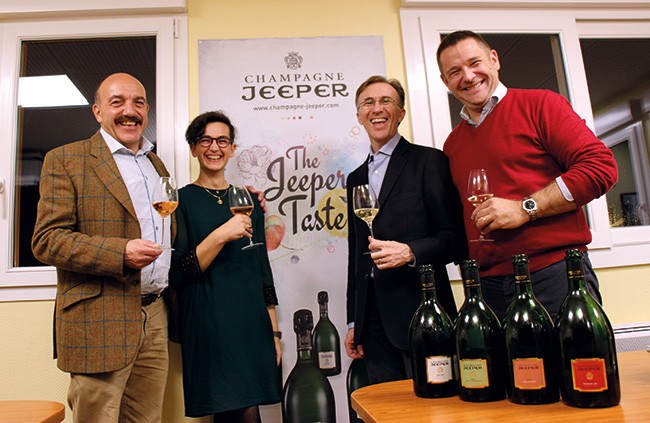
Jeeper? The story of the brand started in 1949. It draws its name from the Willys Jeep given to Armand Goutorbe, a young intelligence officer who guided the allied forces, who got injured, made prisoner and who kept his secrets. The US Army gave him a Jeep to reward him for his silence in order to crisscross his vineyard.
That is how the brand started under the signs of daring and new freedom. In 2009 Myriam and Nicolas Dubois purchased Jeeper with the project to make it grow. “When we arrived the wines were good but we wanted to make them more exclusive thanks to their typicality. We thought everything over, from the quality control to the shape of the bottle with its round curves.” Twenty years later, it has produced results: 350,000 to 400,000 bottles produced and sold every year with 70% at export, in Japan, Australia, of course in the United States where the brand is a kind of ensign.
“Moreish, daring, approachable” are the words chosen by Marie-Luce Thiery, cellar master for 8 years, to define Jeeper's style. A precise style based especially on their favourite grape variety, Chardonnay, on a broad range of crus and elevage in wooden barrels. A bias that demands precision and investment made possible thanks to Michel Reybier's arrival (Cos d’Estournel) who considers that the notion of time and product is essential. “We now have the 3rd biggest stock of barrels with 1,000 small 228-litre barrels for the elevage and 200 'demi-muids' for the vinification. At Jeeper, when we blend we have to taste and sort 1,700 to 1,800 samples. We want to reinvent the style every year. We seek tension, a lovely oxidation. This year we harvested stock after stock to weigh and see if we could notice differences in aromatic potential … We are fairly satisfied,” says Nicolas.
This Premier Cru, stemming by 90% from the house's vineyard, will come out of the cellar by the end of 2017 with an upmarket positioning: €95.00 public price, “with a more gastronomic than aperitif profile”. The brand keeps on playing the card of boldness, definitely a part of its genes, its story, its secrets.
Jacques Tissier runs a 5.5-hectare vineyard in the South of Epernay, in the Sezannais area and, since a few years, in Cramant-Cuis and Epernay. Champagnes that are vinous, airy, deep, earthy, straightforward and free from snobbery. But note that they are endowed with a delicious finesse made of wisdom, a beautiful wine grower philosophy and the taste for good work.
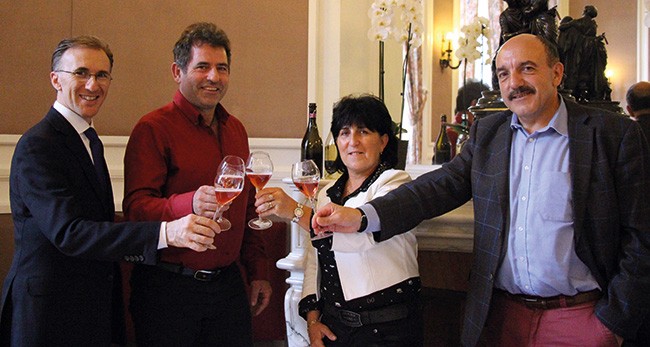
In the Tissier family, it was Diogene, the pioneer in 1931, who started the wine adventure, succeeded by Jean-Marie and Suzanne who had 7 children. The youngest of them, Jacques, followed his parents' steps with his wife Marie-Christine. The young woman from Franche-Comté fell in love in the vineyard. Since then they practice the traditional harvest with the inevitable 'cochelet', the feast held at the end of the picking period, with quails with grapes, farmer’s soup, Ratafia... Jacques and Marie-Christine uphold the tradition. It is the rule when one comes to harvest at Champagne J.M. Tissier. They are 25, from 18 to 72 years old, and come back every year for their 'Tissier-therapy' as they say, loyal and united for every vintage.
Marie-Christine and Jacques welcome them with a vine shoot fire and a purée with lard in the early morning when the sun rises over the veneration of the grape and the angst of changing skies. Nobody knows about the autumn pact, except the Tissiers maybe: “We transmit them the Love of our profession as we did with our children Gaetan and Anthony” they say. Love with hard and rough hands like those who work the land. At J.M. Tissier, they make Champagne with heart and soul, and they give it delicate names that show the subtle alliance of humility and true convictions: Reflet de Terre, Eclat de terroir, Eden de Rosélis in the Terroir range, and for the premium range, Ancestrale, Délicatessence, Génesis. Names that evidence Jacques' deep respect for his soils, his will to understand his environment that gives him the open-mindedness necessary to progress. “Before, we used to craft simple blend champagnes, only non-vintage bruts. I created terroir champagne and vintage champagnes.” His wife, admiring, adds: “He works his vineyard like a garden.” For example, he is trying organic farming on some of his plots, ploughing, using organic fertilizers to find a balance. In the cellar Jacques is trying vinification in barrels, “stopping the malolactic fermentations to keep more freshness”. Tissier has his fans. 70% of the 36,000 bottles are sold in France to individuals and 30% at export. The J.M. Tissier Champagnes thus go to discover the world thanks to Belgium, Italy, Czech Republic, Japan, the United States ...
A sixth cuvee will be released in 2018, a Blanc de Blancs crafted with one of his sons, resounding like a birthday. Jacques took over the domain in 1998, nearly 20 years ago. And a Blanc de Blancs to celebrate longevity. Jacques has one more dream before he hands the reins down to his sons: buy a press, “the real one, a Coquart, a horizontal press to work plot by plot and develop the work with barrels”. At J.M. Tissier, history continues ...
Collet based in Ay has created the Chef's Cookbook Prize in 2013. An innovative way to approach the world of gastronomy and find a place on the table. A degustation segment that breaks with the aperitif moment to which Champagne has long been limited ... We met Pauline Guiset, the young marketing manager.
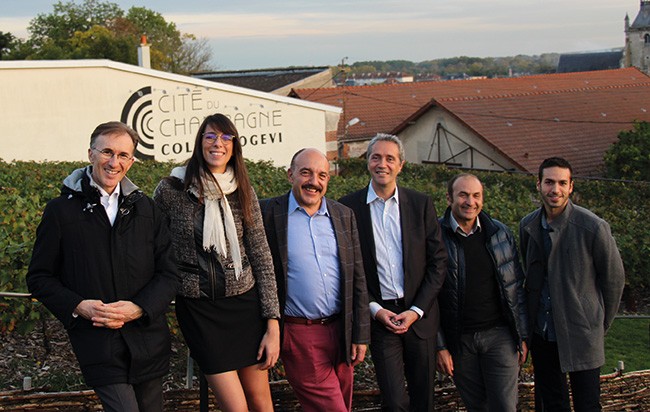
Champagne Collet is the brand of the oldest cooperative, Cogevi (General Cooperative of the Wine Growers of Champagne). Which are the values that you wanted to set forward when creating this prize?
Collet is positioned upmarket (wine shops, restaurants) with an average production of 600,000 bottles. With 12 cuvées our range has been designed to match an entire meal. We just had to imagine a strategy to find a place on the finest tables. We created the Collet Champagne Chef's Cookbook in 2013. Beyond the logic of prize, a cookbook also is a work of sharing, of transmission of a culinary heritage. And that is one of the fundamental values that guides Collet organized in a cooperative with 800 members. It is not only a question of highlighting a cuisine, however qualitative it may be, but also the sincerity of an approach.
How does this prize work?
The principle of this ‘wine-litterature’ prize is to reward great cookbooks of chefs who present live their recipes in front of a jury. During the tests each dish is proposed in pairing with a Collet cuvée. The jury consists of journalists, gastronomy, photography and editing professionals. This enables us to establish our legitimacy in the chefs’ sphere and improve our visibility with prestigious restaurants. Since we created the prize, we celebrated 50 prestige dinners and 300 food & wine pairings.
It has also become a genuine wine & gastronomy creative laboratory ...
Absolutely. The house draws new inspirations in this prize. Our cuvée Rosé Dry, slightly sweet (26g/l), has been designed especially within the framework of the prize in 2015. We launched this wine as an experience to accompany red fruit desserts but it met an amazing success, namely with women. We sold the whole production in a one-year time, as much as our Brut Rosé!
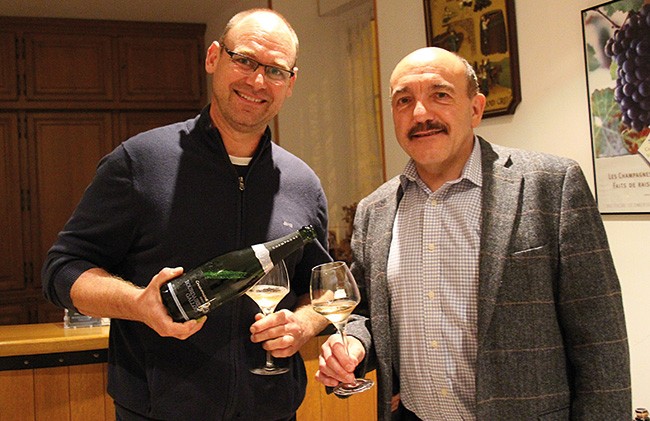
At Bourdaire-Gallois, each visitor is welcomed with a ritual. Here, before you taste a wine, you smell the earth, touch it, look at its nuances of brown and ochre and try to understand. David Bourdaire is part of this generation whose glaze dig furrows like those of his lands. He loves this mysterious matrix and believes in the expression of the terroir long excluded from the Champagne tradition.
In Champagne we recognize (most of the time!) the grape varieties: Meunier, Pinot Noir or Chardonnay. But we know less the taste of the sand and the clay. That is David's work: free himself from blending, perfectly know his terroir and work with the nuances of the soil. At Bourdaire-Gallois, we are in the North Pole of Champagne, at Pouillon, where the grandfather set up the cooperative in 1951.
“I make my wines according to the soil, I separate the villages and the rootstocks which gives me a wide range of flavours to compose my 6 cuvees. The oldest plot of land I have dates back 1922 but the average age of my vines is 48,” says David. The vineyard is planted by 85% of Meunier that blooms for the biggest part on sandy and silty soils, light and draining.
In 2001, when he decided to become a winegrower he immediately purchased a press and considered the soil and water: he sowed grass between the rows, tried to use compost, reenergized his land with a microbial activity and finally converted to organic farming. He tries to refine the guideline of his identity, “let the aromas of the terroir speak, a salty minerality that goes very well with Japanese cuisine”. Incidentally the Japanese are very fond of Bourdaire-Gallois champagnes. Out of the 30,000 bottles 50% are sold at export out of which 20% in Japan. “The Japanese look for authenticity, they love organic wine, I have been surprised by their level of knowledge. I have the most technical discussions in Japan.”
And on the technical side, David also observes and experiments: “Maybe I will stop the malolactic fermentations on some of my cuvees. I make my non-vintage brut every year. For the rest, it depends on what I feel. During the fermentations there is nothing written in advance.” Bourdaire-Gallois builds its reputation upon the notion of emotions and thus finds the virtuous originality of its wines.
Meunier… An iconic grape variety of Champagne long ill favoured. It is said to age badly, to give a musky aroma, to be useful only in blends. At the Demieres in Fleury-la-Rivière it is pampered with 100% Meunier cuvees and is matured in solera since 1978 …
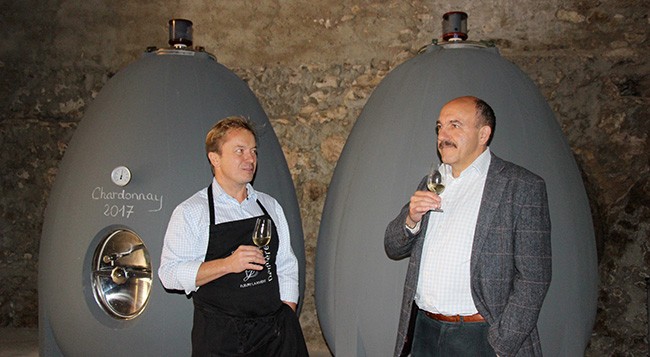
This variety needed time to find back its letters of nobility and equal the Champagne 'stars'. “It is Audrey's father (Jack) who had the idea to start the solera of Meunier to smoothen the DNA of the house. It is a kind of perpetual and dynamic cuvee in which the old wine educates the young one: only 15% of wine added only in the good vintages,” Jerome, Audrey's husband, tells. The young couple at the head of the estate for fifteen years made it its flagship. “Here we have clay and limestone soils on a sand and limestone subsoil rich in fossils, we do not have pure chalk. To me the key is in the soil. The Meunier feels good at Fleury. It develops surprising aromatic abilities. That is why I propose 100% Meunier cuvees,” Jérôme explains.
Their cuvee Egrég’Or (latin origin egregius, “that stands out of the herd”) deliciously meets this requirement. “A tense wine with a powerful nose with scents of mandarin and Mirabelle plum and lavender honey in the finish,” Best Sommelier of the World Gerard Basset comments. There are not many cuvees of Champagne that take up the challenge to set at such a high level the aromatic refinement with one and only grape variety that covers 50% of their vineyard.
But they have to promote it. The Demieres joined the Meunier Institut association and turn towards exports. 12 cuvees produced by 65,000 bottles every year are sold in France, Japan and England. “In France we sell 90% to a traditional clientele of individuals. We developed a project of Champagne tourism with a cottage of 7 rooms (14 persons) '45 Beauregard' that offers a bird's eye view on the valley. Our goal is to target an international clientele and to develop exports. It is what is dear to my heart for the next years”.
Now their organic bubbles shine in the firmament of the mythical champagnes, collecting the most laudatory feedback. The De Sousa Champagnes nurture a taste for secrets,
a peculiar alchemy, set under the symbol of the ammonite, a 4-million-year-old shellfish to be found everywhere in the Champagne subsoil. And an emblem has always something to tell …
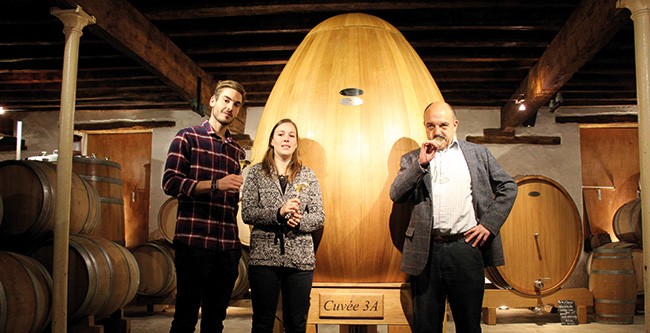
The ammonite symbolizes the perpetual motion. At De Sousa’s in Avize in the heart of Côte des Blancs, this is what they tell you, about a living world that radiates, about men’s sin of pride when trying to dominate it instead of accompanying it, about the fertility of the soils, about horse ploughing not to pack it, about horse tail tea that improves the defenses against mildiou and oidium, about horn silica, ‘revitalized’ before it is sprayed over the vines … even before they speak about wine. And in the cellar same attempt to solve the mystery of the perfect balance: an egg-shaped wooden tun with the proportions of the famous golden ratio holding the 3A cuvee; a piece of rock crystal to increase the vibratory rate of the place and contribute to a better development of the aromas. “We keep on testing. Does horse ploughing have an impact on the quality of the grapes? Is there a difference when we play Mozart during the fermentation? Maybe in 15 years we will have answers, it is very difficult to measure, but we are continuously seeking new quality improvements …” Valentin explains.
A conversion—as everybody knows—is never finished, though since 2010 the Certified Organic stamp is on the label and 2014 for the biodynamics. At the moment only 1% of the surface area in Champagne is grown organic. “It is a philosophy, not a commercial choice. We asked for the certification to meet our customers demand, especially on the export markets (65% of the production) that needed ‘proofs’. But for us it is not a quality argument. We first present ourselves as Champagne de Sousa, then we talk about our approach”, Charlotte underlines.
They sell 10 cuvees, from €28 to 145. A wide range stemming from plot selection and Erick’s and his 3 children’s exuberant imagination, Charlotte at the sales, Valentin in the cellar and Julie in the vineyard. “70% of our wines are vinified in barrels. We separate the Grand Cru plots of the oldest vines, we harvest ripe grapes, we reduced the dosage to gain purity, after bottle fermentation the wines age on the laths for two years for the entry level, five years for the Caudalies cuvee. We still riddle by hand to re-suspend the lees …” The result in the glass?
“A vibrant nose, sometimes exuberant, with lovely notes of custard cream, or wild spices with a mineral finish, cuvees worth ageing, unctuous and extremely elegant” says Best Sommelier of the World Gerard Basset with enthusiasm when he visited the domain. Under the sign of ammonite, infinity and eternity …
Whereas his peers give this variety a very small share, the winegrower of Baslieux-sous-Châtillon decided to make it his king varietal, setting it under the spotlights, as an iconic figure. Its rivals walk on his roots? No matter what, it reigns supreme on Eric Taillet’s 6 hectares who doesn’t hesitate to mention “Meunier producer” on his bottles. A legend is born.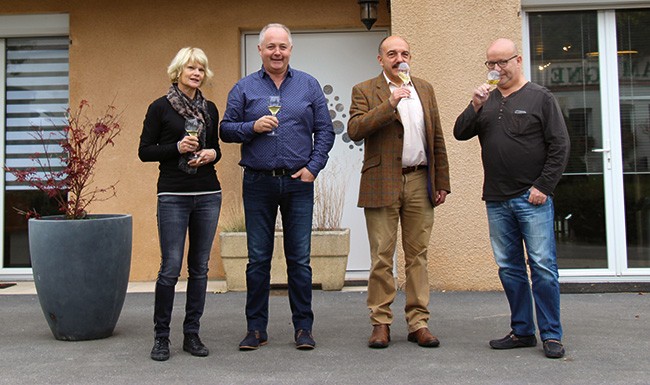
At the head of the domain for 20 years, Eric Taillet never stopped prospecting, listening, feeling the geography of Champagne to understand the nuances. When one knocks at his door, he first talks about his land in Baslieux-sous-Châtillon in the Marne valley, northwest from Epernay, that he feeds with Norwegian seaweed regularly imported for more than ten years, about micro-organisms reintegrated in the soil and about grass cover.
Then he tells about Meunier, his passion, the focus of all the attention. And he takes you in the cellar to make you taste his still wines. That are divided up into 4 categories, in separate tanks according to the pressing cycle, thanks to the Dollat his press installed in 1970. “The quality of the first, second, third pressing is different. Why should they be blended? We gained precision by separating them” Eric states. Later Eric made plot selected cuvees that he has just started to sell.
In short, here, they do not make Champagne, they create it. And it all starts with Meunier, although Eric continues to blend: the reserve wine is a 100% Meunier solera, and the 100% Meunier cuvees are to become the upscale cuvees. In 2016, a confidential extra brut ‘Bois de Binson’ (approx. 1,500 bottles), 100% Meunier single cru, has been released, followed in 2017 by the cuvee ‘Sur le Grand Marais’, in the same spirit. The major part of the crop is used for the production of the house, approx. 35,000 bottles of which a big part is sold in France; the export part is growing. Switzerland, the United States, Italy are their favourite destinations. But with the association Meunier Institut that he created in 2015 Eric Taillet intends to promote Meunier all across the world.
Here we are in the southern hills of Epernay, in Brugny at the Oudarts’. They have a quiet family story in which each generation has participated in the evolution of its vineyards. The father privileged the extension of the lands whereas his descendants developed other initiatives.
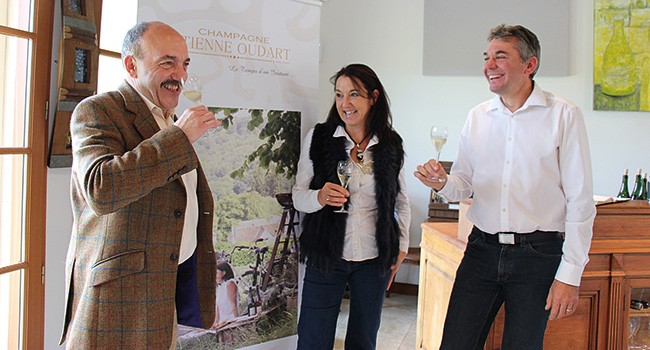
Currently in charge of the family estate, Jacques, his sister and his wife strive to ensure continued existence to the founding values of the estate by producing graceful, vivid and fresh champagnes. Here they serve the vineyard—9 hectares in total—whereas so many other abuse it: no more weedkillers for 15 years, mechanical weeding in compliance with the principles of integrated and sustainable farming.
On the wines’ side no stylistic performance that flatters the winegrower’s ego, but a consistent identity, following an inalienable principle that a good house is assessed through all its wines and praises epicurean virtues. To enjoy “in a moment of time” as Jacques and Karinne explain. Making their own the famous adage of a philosopher: “Fully enjoy the present moment because only present is the time of pure happiness of existing”.
If they make pleasure available through 6 cuvees they also give pleasure through a certain sense of hospitality. Dark red, plum or taupe, the hostess successfully redecorated 4 guestrooms. No bedhead made of vine stocks or walls covered with corks, but a few curiosities like a rust-coloured bicycle to support the washbowl, or special attentions like the small lounge to share a last bottle with friends.
Outside, Karinne is creating her Aromas Manor. Another Epicurean curiosity. The idea is to create a sensory visit focusing on the aromas of Champagne, evoke sensations and awake our ability to perceive. The leaves of various plants are growing around the house. Soon the visitor will be able to smell the heady aromas of herbs, flowers, fruits … to train his nose. About the Chardonnay 2009, Best Sommelier of the World Gérard Basset, visiting the domain, says: “Aromas of Mirabelle plums and candied fruits with slightly spicy shades”. The promise of a lovely garden!
As for Jacques, he wants to develop export. “We sell 80% of our production to individuals. Since 2010 we have built reception and communication tools, and we have started working with professionals, both with HORECA and at export.” Taking advantage of Gerard Basset’s visit, Jacques asked about the relevance of his range for this new strategy. The Best Sommelier of the World 2010 answers: “The wines have a personality, a fresh style, roundness, a suppleness that reveals a fair elegance.
They are pleasure Champagnes! Maybe should you create another cuvee to stand out, something more structured, like a Blanc de Blancs?” A new challenge for the carpe diem wine grower …
We never know what digression in a history can turn into a hallmark. At Palmer & Co, it is a funny story about gentlemen wine growers having a cup of tea and about a commercial challenge. A story with a biscuit, not the pink one from Reims, but a British one …
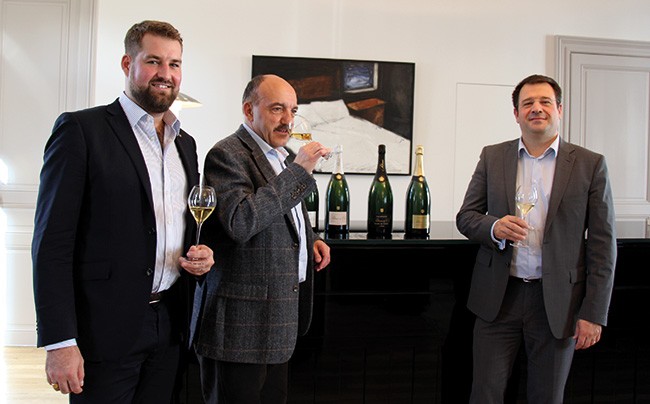
It took place in 1947, just after the War. 7 visionary wine growers from the Reims mountain and the Côte des Blancs area had the dream to launch a bottle, not in sea but at export, especially Great Britain. Of course they needed a structure, they thus created the cooperative. And then a name, one that floats like an ensign, worth their ambition. The legend says that the name Palmer has been inspired by British biscuits much appreciated in the salons in Reims at that time, the Huntley & Palmer biscuits. They chose Palmer!
Seventy years later, Palmer totals 60 employees, 320 members on 415 hectares and 10 Coquart presses. 800,000 bottles of the brand Palmer are produced and still wines are also distributed to the big trade houses.
Although the house remained quite discreet, it has always worked subtle blends.
“We sublimate the wines when we blend them, we seek the roundness of Verzenay, the lemony side of Trepail … And we now want to perfect our communication by sharing more with the general public about our crafting secrets”, says manager Remi Vervier.
Because at Palmer a spirit blows its values since the beginning. At the same time the respect for the material, the important proportion of reserve wines, the care given to blending and the respect for time. “Now the production is exclusively available in the HORECA and wine shops in France and at export in more than 40 countries (70% of the volumes) with historically a strong presence in England”, says François Demouy, son of a historian of Reims and the communication manager of the house.
Beside its standard range of 8 cuvees, Palmer produces a niche cuvee created in 1978, Amazone, composed of several vintages like a solera made with the best grapes of Chardonnay and Pinot Noir from the Mountain of Reims and having a long ageing period of 10 years. In the cellar, the house also keeps an important collection of old vintages among which the historical 1947.
The house sells vintage Champagnes from 1979 to 1999 in a range called “Collection”. “We have a beautiful brand, we have strong values at Palmer and we love to share them with as much people as possible,” says Rémi Vervier. Palmer now wants to write its greater history …
More and more Champagnes release single cru or single plot wines. Just like Philipponnat with its legendary Clos des Goisses, an elite bottling become real cult.
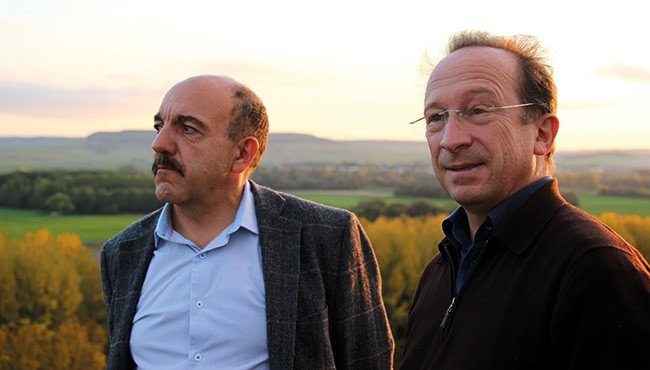
It is a breathtaking plot of land that keeps a kind of unapproachable aura. We look at it from a distance or from above in front of the reflecting Marne whose meanders idle voluptuously under the beautiful last red sunrays of automn. It is the slope of Clos des Goisses, Philipponnat’s jewel at Mareuil-sur-Aÿ, whose vines surrender to passing time over 5.4 hectares enclosed in walls, and divided up into small plots limited by milestones bearing the names of Grands Cintres, Le Chalet, La Dure …
Unique of its kind, with an extraordinary location, facing south, preserved from the prevailing wind, lying on pure chalk, Clos des Goisses is a cult wine before a Champagne, sought after by many connoisseurs. Another specificity, it is a Champagne stemming from a clos, which means it can be crafted only with the crop of that plot of land only. It is thus a single cru wine, too bad for the golden rule of blending, the hallmark of Champagne!
Since 1935, Clos des Goisses is the flagship cuvée of the house that runs 17 self-owned hectares of vines, declared vintage every year, contrary to the other great Champagne houses who declare vintage only the greatest years. Its strong identity, its local and historical roots find their expression through almost 100% Pinot Noir. On some of the plots, weeding is manual, as the slope makes work difficult—‘goisse’ means ‘hard work’ in the old dialect of the region. In the cellar the 14 plots of land of the clos are vinified separately. “For Clos des Goisses, the production varies depending on the year: 3,000 bottles in 95 because of frost, up to 23,000 in 2008“, states Charles Philipponnat who is at the head of the house since 2000 and works to herald a genuine signature. “Our hallmark is Pinot Noir. We want to combine aromatic purity, a slightly salty minerality and keep a fresh and vivid acidity. Restaurants are getting increasingly interested in this style.”
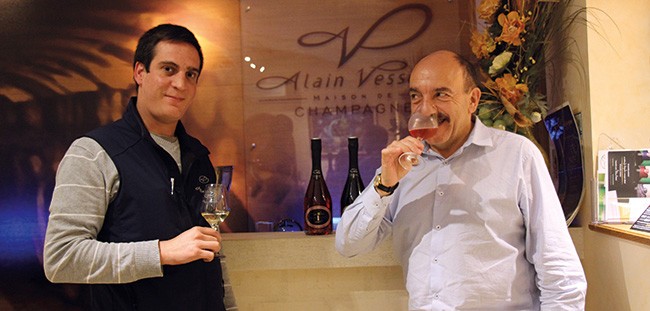
Since 1885 the Vesselle family has been growing vines and making Champagne wines on the terroir of Bouzy, classed 100% Grand Cru on the southern slope of the Mountain of Reims. In 1979, Alain Vesselle handed over a family savoir-faire to his son Eloi Vesselle. For 4 years Guillaume Vesselle, one of Alain Vesselle’s grandsons, took over the reins of the family company.
Guillaume is the oldest of a sibship of three boys. Being the oldest of a lineage of wine growers means being the unquestionable guarantor of the continued existence of a name, a brand, a profession … Guillaume grew up with a family savoir-faire. His two brothers are finishing their studies: marketing for Antoine and wine tourism for Thibaud.
Guillaume started by restructuring the visual identity of the labels and would like to develop his Saint Eloi range for 2020 and turn towards export.
“With our 18 hectares of vines, we produce 80,000 bottles, the rest is for the trade. I sell 95% of the production to a clientele of individuals in France and Belgium. It is a loyal clientele through several generations. Now, the grandchildren of my grandfather Alain Vesselle’s customers come to buy our Champagne. It is rewarding! In the upcoming years I would like to develop exports.”
The Gruet house, located in the Aube region at the heart of Côte des Bar, continues to grow. With new facilities, the house produces vintage or original Champagnes with rare grape varieties like Arbane, 100% Pinot Blanc cuvees or blending Arbane, Pinot Blanc and Chardonnay.
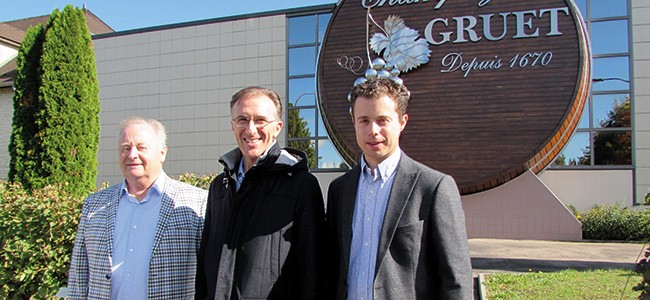
Gruet settled at the heart of the Aube department, realm of the Pinot Noir. Claude Gruet who took over the reins from his father in 1975 and become a merchant in 1993 has been working hard over the last 40 years to build up his Champagne house. “With my son Pierre-Charles, even on Saturdays and Sundays, we crisscross the vineyard. It is impossible to manage a vineyard from the office“, says as an obvious fact the tireless worker stemming from several generations of winegrowers settled in the Côte des Bar area since 1670 and who has a wealth of stories to tell about Champagne.
At Buxeuil where all the production has been centralized—from pressing to blending and storing—top-notch and multi-certified facilities show the scale of this house: impressive thermos regulated tanks for the first fermentations, automatic disgorgement by freezing center … “Since 2016 we invested in 16 elevage tanks of 420 hl and new storage warehouses in order to increase our volumes and the quality of our vintage Champagnes that age for 5 to 7 years. All this is to meet the increasing demand of prestige wines for the restaurants and a clientele of individuals,” says Claude Gruet who has several of his cuvees that have won many prizes, to mention only 2017: Chardonnay of the World for Gruet Chardonnay Brut 2013, Vinalies d’Or for Gruet white vintage 2012, Mondial du Rosé-Cannes for Gruet Bled Rosé …
De facto the house’s new products tasted by Best Sommelier of the World Paolo Basso show an excellent quality-price ratio (€15 to €35), the strength of this house. Aged 7 years made with a 2009 basis, the Brut “Des 3 Blancs”, a blend of Arbane (50%), Pinot Blanc (25%) and Chardonnay (25%), displays an attractive crystal-clear robe, then seduces with aromas of “white pepper, white blossom, pineapple jelly and tropical fruits” and its roundness on the palate. Likewise, the very original Gruet Cuvée Arbane, drawing its personaliity from the Arbane grape variety, with rich flavours of tropical fruits with a “touch of passionfruit”, perfectly matches light fish dishes.
Floriane Eznack, Champagne Jacquart’s cellar master since 2011, creative and lively, gives the range of Jacquart a new impetus. Encounter with the young winemaker in the impressive Hotel de Brimont, head office of the house since 2009.

For ten years, Champagne Jacquart is repositioning the brand. Why?
We undertook to progressively reposition the style with a reduced range focusing on the collection Mosaïque and the vintage Blanc de Blancs, iconic cuvees of the house. The brand created in 1964 is contemporary, and the style of the wines is naturally impacted, showcasing the airy freshness of the Chardonnay, the fine texture and straightforward wines immediately pleasurable. Our strength is a varied and sustainable supply from all the terroirs of Champagne. The Mosaïque collection is made of 5 peculiar cuvees that all share the same blend of Mosaïque: 40% Chardonnay, 35 %Pinot Noir, 25% Meunier. Different dosages and ageing times are adjusted according the style sought after and the targeted tasting moments.
In the Mosaïque collection, you released the cuvee SIGNATURE a year ago? What are the characteristics?
Dedicated to a selective distribution and starred restaurants, Mosaïque Signature will be disgorged after only 5 years of ageing on the lees instead of 3 years for the Brut. The wine is cellared for the bottle fermentation and matures slowly on the lees. Meanwhile, in cellars with a consistent temperature, quiet and dark, the Mosaïque blend blooms and the bubbles refine.
The Chardonnay, soul of the house and dominant grape variety in the blend has a slow evolution. The adjusted dosage and the long time on the lees strengthen the freshness and aromatic richness of the wine.
Among the Alpha prestige cuvees a new one has just been marketed, ALPHA Rosé Vintage 2010. What is its personality?
By favouring quality over volumes Jacquart chose creativity, contrary to more traditional houses. The Alpha cuvee, iconic of Champagne Jacquart, is both a symbol of infinity and beginning. This cuvee is a research, a reflection, a re-interpreted selection for each new vintage that expresses a peculiar elegance, a style marked by precision, powerfulness and depth.
For this cuvee, what I first liked was to work with the structure, seeking for depth and finesse, and to find the most harmonious balance between Pinot Noir (48%) and Chardonnay (52%), selected in our best terroirs. Each cuvee will be different from the previous one—likewise the design of the case that will change every year—with the idea of experimentation and continuous open-mindedness. That is why we chose the name Alpha that symbolizes “first” and “infinite”, and beyond the name, the ambition of an endlessly renewed adventure.
At Baroville in the Aube department the Champagnes gathered within the Champagne de Barfontarc cooperative increasingly gain delicacy and sensitivity, rewarding the subtle work done for 10 years by three generations of female enologists.
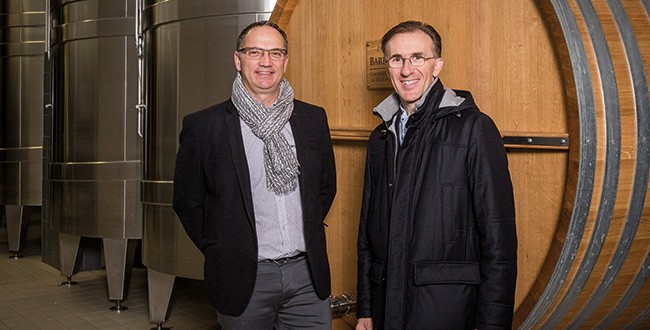
Manon Marcantonio, enologist, trained in Reims, has joined Barfontarc only since the 2016 harvest, in a cooperative whose wines, characteristic of Cote des Bar, unfold through the decades. “Thanks to general manager Olivier Martin’s support this house shows a real dynamism, a will to evolve with the times using new technologies, and it is very open to new ideas,” says the young lady who succeeds to other female winemakers, Quitterie Mora and Aurélie Ponnavoy, “which, it’s true, has given over the last ten years a touch of softness and femininity to the house’s blends but also in the way we work”. Moreover from 1962 when the cooperative was created they already had two women among the member winegrowers, underlines Sonia Pereira, in charge of the France and export sales of Champagne de Bartonfarc.
From the slender shape of the bottles with names like Sainte-Germaine, their vintage Champagne, to the cuvee La Vigne au Roy 2008, decorated with periwinkles, roses and lilac … everything in this house as undeniably a feminine touch. It can also be felt in the sweet first taste (10g), the fresh mid-palate and the citrusy finish of Tradition Brut, aged five years, Pinot Noir based (74%). Just like the delicacy of the blend of the cuvée La Vigne au Roy Brut 2008, half Pinot Noir half Chardonnay, now at its peak according to Best Sommelier of the World Paolo Basso, “with scents of dried flowers, golden apple, mild spices and hazelnut in the nose, a beautiful palate supported by an acidity that gives a lovely vividness, and a mid-palate with a salty touch that gives a very original peculiarity … And a properly calibrated dosage”.
Result of a two-year work with a more rigorous sorting of the grapes after harvest, Champagne Barfontarc Derrière Le Moulin Brut Blanc de Blancs 2012, aged by 40% in oak barrels, with a good quality-price ratio and perfect for refined aperitifs or fish dishes, as well as Extra Brut Bled Rosé or Brut Nature 2009 evidence the same delicate and fine savoir-faire … “It is true that women have a special touch, a talent, a 6th sense to understand sparkling wines and sweet wines”, says Paolo Basso, “and here we have wines of sensitivity”.
Janisson's style firmly asserts itself: fine, sleek, elegant wines with one flagship, very essence of their savoir-faire, the Blanc de Noirs.
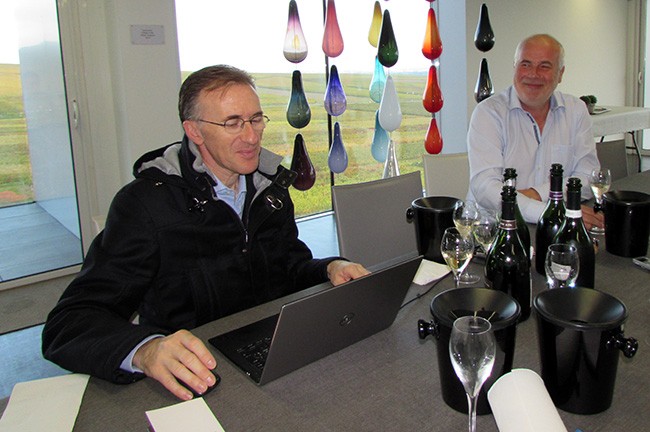
At Janisson's, in Verzenay the dominant white colour–from the gigantic lights at the entrance to the immaculate walls of the tasting room–, the straight, cubic and sleek lines of the ultra-modern building signed by Giovanni Pace, are all incarnations of the house's very own style. With a breathtaking panorama–rare in Champagne where the houses are often far from their lands–over vaste areas of vines, shimmering in autumn with thousands of ochre and orangey shades. A symbol in itself of the importance given to the raw material, the earth and the vine, before making skillful blends. At Janisson, they focus on the very refinement and core of all things.
When they met Paolo Basso, the degustation started right away, the important is not the speech but the nectar. The range of emotions started with Janisson Brut tradition, the house's flagship cuvee that represents 75% of their sales. Made out of 70% Pinot Noir and 30% Chardonnay, aged 30 months in the cellar, it displays intense spicy scents, “followed by aromas of yeast, golden apple, candied apricot, a lovely sucrosity and a voluminous structure well-balanced by a good vivid acidity that provides character to the wine”. According to Paolo Basso, it would be ideal over light sea or lake fish starters.
Janisson Brut Nature is even more delicate and “contemporary” over “fish dishes with buttery or creamy sauces or olive oil to compensate the absence of dosage”. Then they reach a peak of excellence through the discovery of Janisson Blanc de Noirs Grand cru. “It is our signature cuvee, the jewel of our range. A wine stemming exclusively from Grand Crus of Champagne: Verzenay, and 100% Pinot Noir. A very well-balanced wine, well-structured and elegant”, describes Manuel Janisson, chairman of the 'young' Champagne house created in 1990 and who became a merchant in 1996.
Born in a family of wine growers, Manuel Janisson successfully takes up the challenge to combine tradition and innovation to reach the final alchemy: plot by plot sorting and pressing, picking in the finest Grand Crus and no oak barrels to “preserve the natural aromas” as underlines cellar master Cyril Tanazacq, evidencing his search for straightforward and finely tailored wines. The house has the continuous concern to preserve Mother Nature with a more and more integrated farming (organic treatments, electrical tractor, mapping of each plot of land …). “From spring 2018 we will even start experimenting hemp covers to prevent grass from growing between the rows” Manuel Janisson announces. For contemporary wines down to the roots of the vines.
Loyal to its motto “Dare, wine, celebrate” Champagne Mumm is launching a new ultra-select and daring range “RSRV” with one flagship, the Grand Cru Rosé Foujita. In Reims, Cellar Master Didier Mariotti met Best Sommelier of the World Paolo Basso.
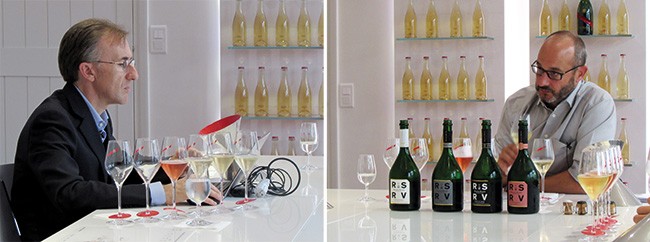
With a salt and pepper beard, fine black glasses and a sportive build, Didier Mariotti, Mumm's Chef de Cave, admits he has been working for fifteen years “with a genuine treasure in 3D, the grape varieties, the terroirs, but also this extra dimension, the reserve wines that provide complexity and moreishness”. De facto in a few years time Mumm's classic and legendary cuvee Mumm Cordon Rouge has little by little, thanks to his work, gained ageing time and extra reserve wines—20 to 30% more. “Now we even have 5 years in reserve which makes up Mumm Cordon Rouge's backbone and enables to make more dynamic certain years or give more complexity to cuvees of this challenger for which we have to guarantee consistency in time”.With in a parallel sterling work done to release the range Mumm RSRV in which the two last cuvees have been launched just before the summer 2017, confidential and outstandingly international even in the name, to pronounce “reserved” or “réservé”.
Renewing the tradition of private cuvees like the mythic Mumm de Cramant or Mumm Blanc de Blancs made only for the house's connoisseurs and fine restaurants, “RSRV is a range of 4 Grand Crus with two single growths and two multi growths, all four dosed by 6 g and aged at least 4 years,” Didier Mariotti explains. Mumm RSRV Blanc de Blancs vintage 2012 highlights the terroirs of Cramant and the “house's heritage” of light and airy wines “with a straightforward, pure and direct spirit” that reveals to be “dynamic, supported by a beautiful freshness and a very well-integrated dosage” according to Paolo Basso. As for Mumm RSRV Blanc de Noirs 2008, an exceptional year for the harvest, it stands out thanks to a smoky and roasted side, confirmed by Paolo Basso who advises to serve it with finely spicy oriental dishes.
Likewise Mumm RSRV Grand Cru Cuvée 4.5 (4 for 4 years of ageing and 5 for the number of growths: Cramant, Avize, Ay, Bouzy, Verzenay), a blend of 35% Chardonnay and 65% Pinot Noir, is a gastronomic wine for fish dishes with spices. At last, based on the same blend than 4.5, Mumm RSRV Grand Cru Rosé Foujita, in tribute to the French-Japanese painter author of Mumm's famous rose, is the top of the range. “When I made this rosé I was thinking of summer, I wanted to find back the acidity of the crushed fruits when I used to make jam with my grandmother,” Didier Mariotti evokes,
“I searched more the lightness than the powerfulness through this basket of red fruits for a wine I first wanted to be refreshing”.
In the historical register room of the Perrier-Jouët house in Epernay, Chef de Caves Hervé Deschamps takes us back in time in a flavourful journey with his new cuvees, “delicate like lace”, Perrier-Jouët Blanc de Blancs and Perrier-Jouët Belle Epoque vintage 2011.
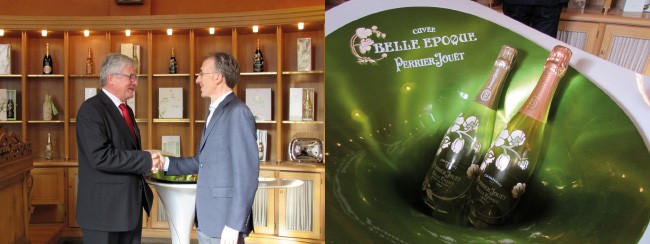
“Back in 2009. I was lucky I could taste a Champagne Perrier-Jouët of 1825, kept here in our cellars of Epernay. It had an amber colour, the nose reminded an old sherry with notes of fig, nuts, dates, but the palate was still generous. It still had a few bubbles, that was marvellous”, says Hervé Deschamps, Chef de Caves since 1993 of Perrier-Jouët, to Best Sommelier of the World Paolo Basso, who is always interested in the dosage and was surprised to hear that some at that time were “close to 150 g/l”. Thus far, two centuries later, from the 8g of the house’s new jewel, a Blanc de Blancs released in last spring, a real tribute to Chardonnay, aged three years in the freshness of the cellars in Epernay.
“The idea of this Blanc de Blancs was to work the most elegant and fresh grape variety that composes the base of Perrier-Jouët, by seeking a floral side beyond the fruitiness and vividness,” Hervé Deschamps deliciously describes. This cuvee stems from new supplies at wine growers from Côte des Blancs and the Grall “Chardonnay”, such a sought-after grape variety absent from their range until now, apart from the vintage cuvees. “It also meets a customer demand for pure and elegant products, for a Champagne that would be more airy than powerful, and delicate like lace. It is particularly appreciated by the Asian customers.”
Floral, finely-knit and elegant, the style Perrier-Jouët is also marvellously represented in the last prestige cuvee Perrier-Jouët Belle Epoque 2011. The bottle in itself, decorated with the famous white anemones created in 1902 by Art Deco master glass maker Emile Gallé, invites to let oneself be caught by the floral scents. In the nose fruity notes of William pear, green pepper, a smoky touch, scents of brioche. On the palate, flavours of acacia honey. And in the finish, it becomes a real nectar, to be served with “a delicate cuisine of fish or poultry with savoury sauces, possibly spicy and oriental” according to Paolo Basso, moreover seduced by the “level of excellence” of Perrier-Jouët Blanc de Blancs vintage 2004, “an exceptional Champagne that has to be reserved to high level gourmet cuisine with very exclusive ingredients”. And without excessive acidity added during cooking to let the wine fully express. As there too, it is all a question of dosing.
Granddaughter of the famous house’s founders, Laurence Ployez continues to work according ancient techniques, more demanding but guarantee of old vintages of excellence, sought-after by the finest gastronomic restaurants across the world.
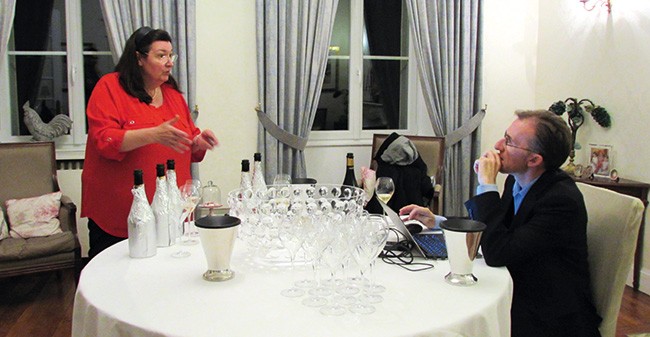
At Ployez-Jacquemart, tradition is not just a surface style. Entering the large estate in Ludes, you can feel tradition exuding from the walls of the house and in an everyday philosophy. First in the two cellars, with one dug 250 years ago, linked by a dizzy passageway at 25 meters deep under the estate. Then in the oak tuns proudly bearing the letters PJ for Ployez-Jacquemart, name of the founders of the house in 1930. And at last in the prestige cuvee “Liesse D’Harbonville”, created in tribute to Yvonne, the grandmother of Laurence, the current manager of Ployez-Jacquemart, member of the third generation.
Ever since she took over the reins in 1988 the master of the place, also the merchant and the Chef de Cave of the house, she has been striving to perpetuate her father’s work with the same high standards. “My father taught me everything, it was tough, he made me work hard but it was fruitful,” she tells. And to her, tradition first concerns vinification, with a specificity here that goes against fashion and trends, against modern technologies and time passing by: the bottles are stored head down. “Indeed we are one of the last houses to age the cuvees head down in order to limit the contact with the yeasts before disgorgement. This method enables to keep the advantages of ageing, to keep the wines longer and fresher,” she describes. Dealing with the constraints–riddling by hand, large storing capacities, continuous search for staff with such a know-how–Laurence Ployez has been searching for years at the “perfectly balanced” grail.
As an evidence her cuvees 1998 and 99 remain extraordinary like Liesse d’Harbonville Brut Vintage 1998, however disgorged in 2007 thus ten years ago, described as “beautiful, savoury, complex, with notes of spices and mild tobacco” by Best Sommelier of the World Paolo Basso during his visit in last autumn in Ployez-Jacquemart’s realm. After 5 years head down, the Extra Brut Vintage Blanc de Blancs 2002, disgorged in 2012, is “fine, delicate, round and floral”, whereas the Extra Brut Vintage 2002 disgorged in 2006 features “a lovely complex nose with aromas of oriental spices and cigar box, a lovely savoury and lingering palate”, in short, “excellent”.
A results that also is the fruit of “the loyalty for more than 45 years of wine growers of Grand Cru Chardonnay, especially in Côte des Blancs”, of a sorting by grape variety, growths and plots, wines kept in oak barrels without malolactic fermentation for the prestige cuvees and finally a very low dosage to keep the structure of the wine. Ployez-Jacquemart’s Champagnes, clean on the palate, very aromatic, masterfully combining minerality, fruitiness and acidity, have for long conquered the finest tables across the world from L’Assiette Champenoise and Domaine des Crayères in Reims, Daniel’s in New-York, or in Switzerland at Hotel de Ville in Lausanne and Domaine de Châteauvieux at Satigny.
Rare grape varieties like Pinot Blanc, a 100% Chardonnay at only 3 bars … Pierre Trichet, a wine grower settled in the village of Trois-Puits, at the foothills of the Mountain of Reims, uses the past history to better create and surprise the palate.
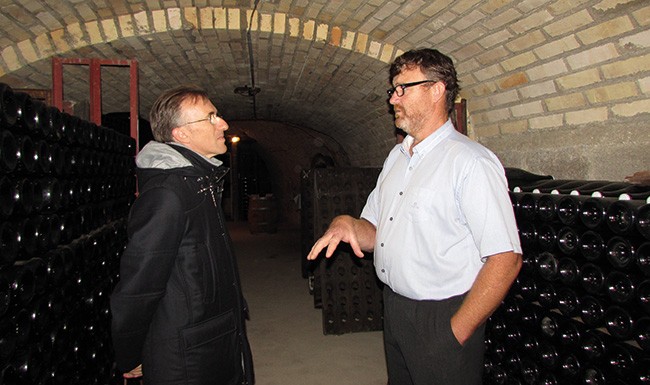
“Yes, it is true, he keeps on testing, searching, experimenting, it is in his nature,” his wife Mireille Trichet says. Under the vaults and in the freshness of his cellar dating back 1783, a labyrinth of 40 meters long under his house, Pierre Trichet, aged 50, works on his blends like an alchemist. “When I took over my parents’ estate in 1986 my father trusted me and let me do what I wanted. I had a listener and my hands free, a great luck,” he says with a grateful look at his father René.
His first creation launched in the 90s, the cuvee Caractère, a Blanc de Noirs Premier Cru, very fresh, with a delicious character, was a good bet. Now it represents 20% of his sales, especially with individuals. Attached to his land and to the history of the terroirs Pierre Trichet did it again, with an original cuvee, Secret d’or, released in 2015, a 100% Chardonnay with a peculiarity: “I bottle it with 3 and not 6 bars of pressure to find back the features of ancient Champagnes, a ‘demi-mousse’ wine [less sparkling], not vivid nor tangy, but with a dosage of 7 or 8g, not 12 like in my parents’ time”. Coming back to the trends of the 60-70s the wine grower with the stubby hands of those who work the land even revived Chardonnay still wines he marketed in autumn this year. “It is a would-be Champagne, I was thinking about it for long, I thought it was a pity that the region had lost these wines.”
But his quest also leads him to search for rare varietals. Pinot Blanc that he rediscovered a few years ago when tasting still wines in Aube completely seduced him. “I planted some, to remain prudent, on a small plot in Premier Cru, willing to create again the wines that could be enjoyed in Dom Perignon’s time”. Just released, his 100% Pinot Blanc cuvee ‘1333’–a name indicating the confidential number of bottles produced and all numbered–opens up with aromas of spices and white-fleshed fruits, followed by beautiful flavours of white pepper and citrus. Something original. “To us, it is different from Chardonnays and Pinots. We don’t know if it is a Blanc, a Noir, we don’t know how long it will keep, if we can improve it … It is the beginning of the story,” says the tireless explorer with a sparkle in his eyes.
Reportage de Marianne Peyri